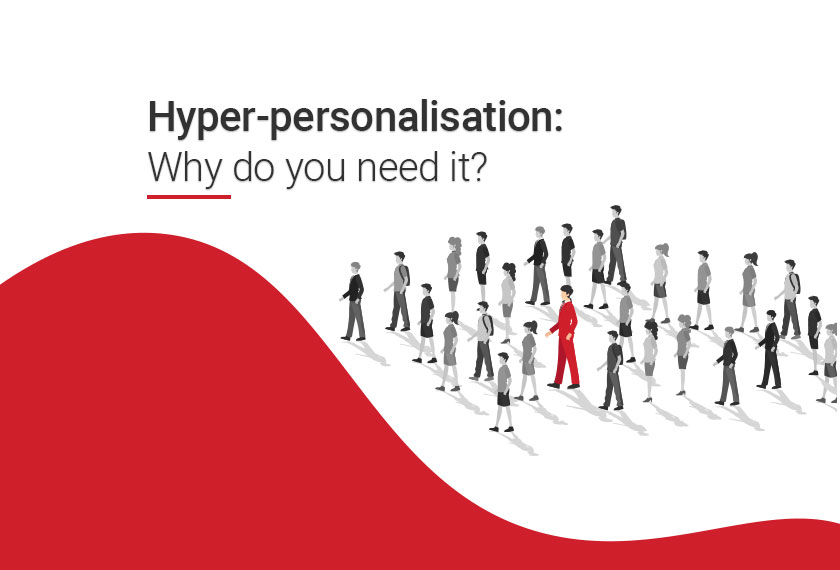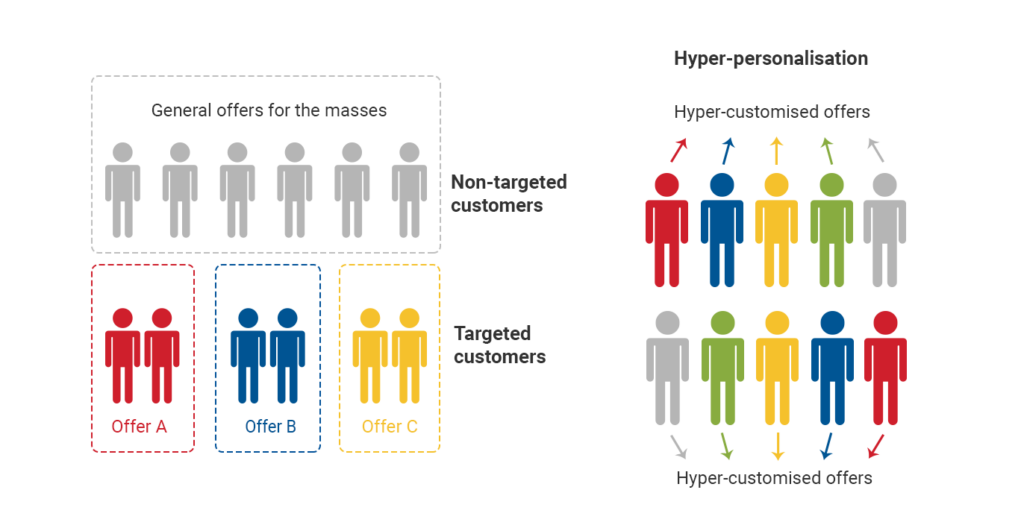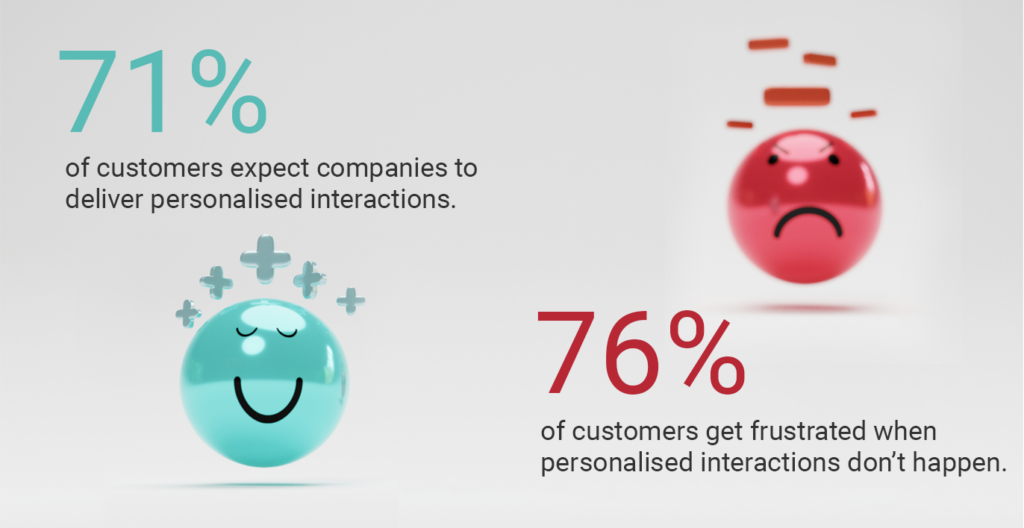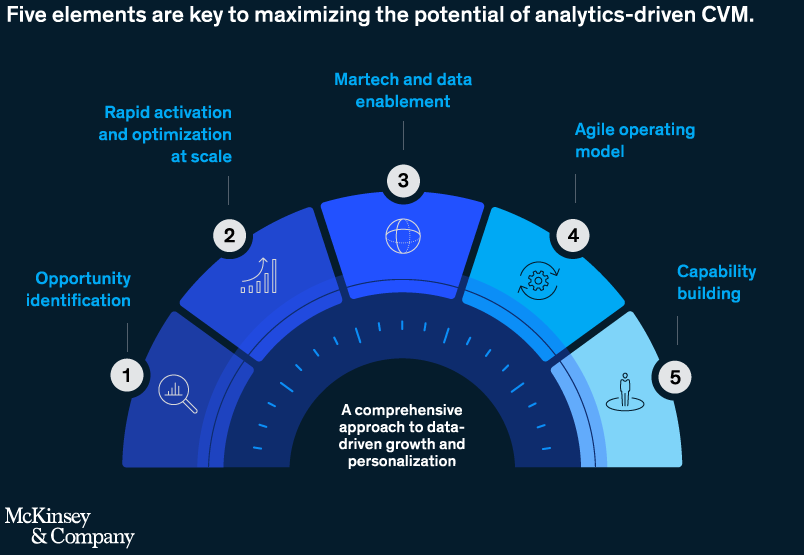
The shift to more personalised, targeted customer experiences is largely due to technological advances, with machine learning, artificial intelligence and biometric identification increasingly integrating to provide more data-based customer information.
In this article, we’ll cover why hyper-personalisation is one of the key drivers of business growth and how to get started with it.
Hyper-Personalisation vs Traditional Personalisation
Before diving into the technologies behind hyper-personalisation, let’s start with the basics:
What is hyper-personalisation? And how is it different from traditional personalisation?
Most companies use personalisation in some way or form. And sure, hyper-personalisation won’t help you read every customer’s mind. However, going beyond that, regular personalisation and segmentation make the difference in building a great digital customer experience. It’s a step forward to building a deeper emotional connection and interaction with your customers.

While traditional personalisation relies on personal, demographic, psychographic, and transactional data, such as name, organisation, address, purchase history, and so on, hyper-personalisation is based on advanced technologies and real-time insights. It allows you to provide hyper-customised services, products, and information to your user or customer.
What does this all mean?
Hyper-personalisation can help you orchestrate experiences at an individual level for every customer. It determines the types of customised interactions and dedicated tailor-made solutions for each of your customers.
And individualised experiences are something your customers want!
In fact, McKinsey’s research shows that 71% of customers expect companies to deliver personalised interactions – and around 76% get frustrated when this doesn’t happen.

No surprise, is it?
After all, if a company understands customer expectations—and shows it through its interactions with them, it’s more likely that it will create more authentic experiences for its customers and build customer loyalty.
Learn more about ‘Why do micro-experiences matter to the IT and support world’.
The Technologies Behind Hyper-Personalisation
Now that we know that hyper-personalisation goes way beyond basic customer personalisation – let’s look at some of the most common technologies behind it:
- Artificial intelligence (AI)
- Machine learning (ML)
- Predictive analytics
- Real-time data
In combination with advanced analytics, real-time data and AI can help you discover what your customers will want in the future. Looking at current and historical data patterns, you will get insights into how to react appropriately to their expectations. Through machine learning models, you can use internal and external data sources to create hyper-customised services and make more relevant interactions with your customers.
Hyper-Personalisation Keeps Customers on the Journey
“McKinsey’s research has found that companies that excel at personalisation enjoy 40 percent more revenue than those that don’t.”
So, is it time for personalisation to become a priority for companies? And aren’t all companies already on top of this?
The answer is yes and no! Although many companies have recognised the importance of analytics and data-driven hyper-personalisation to achieve competitive advantage and maximise revenue growth, only some are already harnessing its full potential.
According to Salesforce, 52% of customers report that the companies they interact with still feel impersonal.
Focus on Collecting the Right Customer Data
It’s going to be challenging to provide personalised interaction, content, or hyper-customised offers for specific customers if you don’t know any specifics about them.
That’s why collecting customer data matters!
When looking at the Customer Lifetime Value (CLV) or insights into which customers you can expect to stick around, you also have to think about the data you need to collect to calculate it.
Remember, the quality of the data matters and only the right data will give you an accurate view of your customers. So, focus on collecting relevant and usable behavioural data from your customers’ daily interactions.
So now, you might ask, how to unlock the full potential of analytics and data-driven personalisation?

According to Mc Kinsey, these five things can help you accelerate personalisation and create long-term value:
- Identify new opportunities. Customer data and analytics can help you identify new opportunities. By looking into the customer life cycle, you can better view their long-term value and leverage customer segments and other factors such as behavioural, transactional, and engagement trends to set new objectives and customer-centric key performance indicators (KPIs).
- Leverage predictive analytics. By leveraging predictive analytics and models, you can personalise the content and messages to your customers. This means you can discover and deliver the right content through the proper channels at the right moments in a consumer’s journey.
- Invest in martech and data enablement. To unlock the potential of personalisation, business use cases need to drive the data. So, think about what data points are required to create the best possible algorithm and how can that data best be collected and used.
- Embrace an agile operating model. Investing in agile teams and a more flexible approach gives you a better chance at scaling the personalisation and driving sophisticated customer value management.
- Invest in talent and training. When building a team, think about the skills needed to support personalisation at a scale and invest in hiring, training, and upskilling that will help this. So, focus on skills such as advanced analytics, product management, performance marketing, usability testing, communication skills, collaboration skills and so on.
Prepare for Hyper-Personalisation
Today’s customers respond positively to good experiences and how specific products, or services make them feel. So, when it comes to personalisation, companies need to demonstrate their investment in relationships with long-term value, not just in a transaction.
And to satisfy, retain, and acquire customers, companies should focus on a more customer-centric, data-driven, and highly personalised approach.
To learn more about customer experience, you can watch the video ‘Human nature and the secret to transforming Customer Experience’
Written by:
Antonija Bozickovic
Content Creator at Service Desk Institute


























